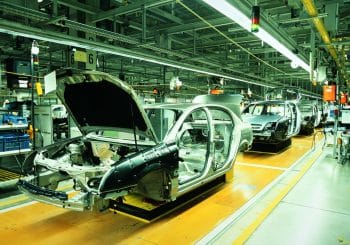
A Tragic Link Between Car Factory Closures and the Opioid Epidemic
Last December, a team of researchers from the University of Pennsylvania published a study in the academic journal JAMA Internal Medicine which found a correlation between Opioid overdoses and the diminishing manufacturing sector of the American economy. “Our findings confirm the general intuition that declining economic opportunity may have played a significant role in driving the Opioid crisis,” the lead author of the study, Dr. Atheendar Venkataramani, explained. According to the study, “automotive assembly plant closures were associated with statistically significant increases in Opioid overdose mortality,” a powerful indicator of the close connection between a person’s economic prospects and their vulnerability to life-threatening Opioid addiction.
Automobile manufacturing has been generally declining in the United States for many years. Car companies have closed assembly plants and dismissed thousands of workers as the industry navigates weakening demand in global markets, tougher regulations on carbon emissions, and the expensive development of electric vehicles.
The Methodology of the Study
As they conducted their research, Dr. Venkataramani and his peers examined industrial and health data in 112 counties from 1999 to 2016. Every county hosted an automobile assembly plant or formed part of a “commuting zone” which depended heavily on car manufacturing for jobs and economic growth. All of the counties which the researchers studied were part of the Midwest and Deep South regions of the country.
In 1999, the first year of the Opioid Epidemic, the counties all experienced similar rates of Opioid-related fatalities. Over the course of the following two decades, as the entire country suffered an increase in Opioid overdoses, the increase in overdoses was substantially more severe in counties where automobile assembly plants closed. In the 29 counties which lost a car factory, the incidence of fatal Opioid overdoses increased by 8.6 deaths per every 100,000 people, an 85% surge in mortality relative to counties which did not experience a factory closure, where Opioid overdoses killed 12 people per every 100,000. The mortality increase occurred within five years of a plant shutting down its operations.
White, working-age men in impoverished areas were the primary victims of this phenomenon. The effect of a factory closure was most drastic for men in this category between the ages of 18 and 34 years old, for whom the Opioid death rate increased by a staggering 20 lives lost per every 100,000 county residents.
“Deaths of Despair”
The Opioid Epidemic has given rise to awareness of “deaths of despair,” the phenomenon whereby economic problems cause or worsen fatal health afflictions. “Deaths of despair” often involve addiction to drugs and alcohol. In towns and cities throughout the United States, a factory closure can be traumatic for the whole community. When a factory closes, men and women lose their jobs and face an uncertain future. As they struggle to find work and provide for their families, they may also bear the prospect of losing their homes. A factory closure often causes people to move away to find opportunities elsewhere, leaving family and friends behind. In such situations, some people develop Opioid use disorders as they seek ways to manage physical and emotional pain. Rampant prescriptions for Opioid painkillers have fueled a drug crisis in the same parts of America where the manufacturing decline has been most distressing.
Dr. Venkataramani views a surge in Opioid overdoses as “a symptom of a community that’s sick.” To heal this sickness, his team recommends a general reduction in Opioid prescriptions as well as the implementation of effective diagnosis and treatment strategies for Opioid addiction in manufacturing-reliant regions. The automobile industry has already begun to recognize its role in the Opioid Epidemic. Last year, Ford Motor Company agreed to donate money to fund Opioid addiction treatment for its employees.